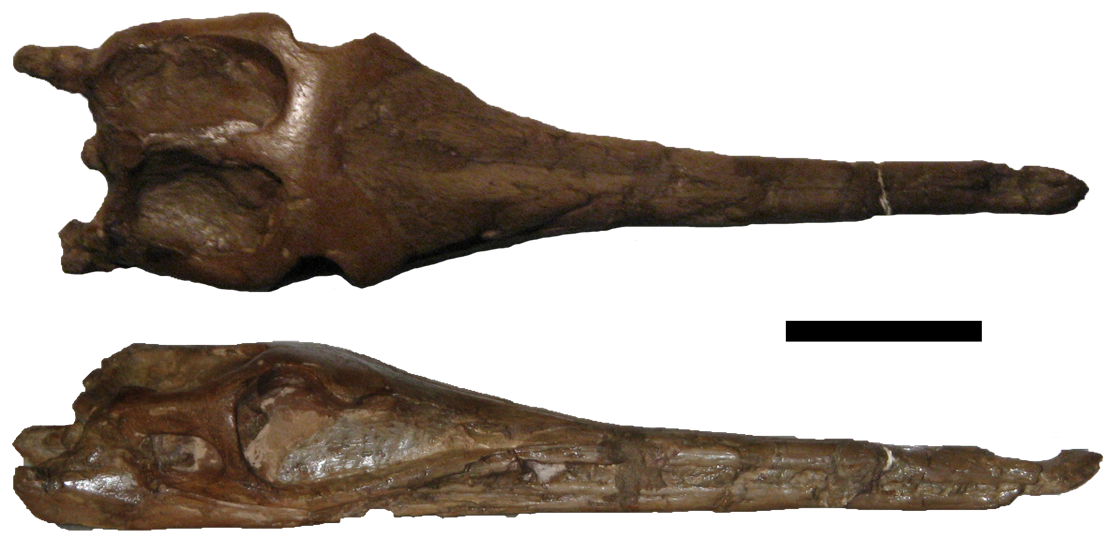Rhacheosaurus on:
[Wikipedia]
[Google]
[Amazon]
''Rhacheosaurus'' is an extinct
 A
A
High diversity of thalattosuchian crocodylians and the niche partition in the Solnhofen Sea
. The 56th Symposium of Vertebrate Palaeontology and Comparative Anatomy
genus
Genus ( plural genera ) is a taxonomic rank used in the biological classification of living and fossil organisms as well as viruses. In the hierarchy of biological classification, genus comes above species and below family. In binomial nom ...
of marine crocodyliform belonging to the family
Family (from la, familia) is a group of people related either by consanguinity (by recognized birth) or affinity (by marriage or other relationship). The purpose of the family is to maintain the well-being of its members and of society. Idea ...
Metriorhynchidae. The genus was established by Christian Erich Hermann von Meyer
Christian Erich Hermann von Meyer (3 September 1801 – 2 April 1869), known as Hermann von Meyer, was a German palaeontologist. He was awarded the 1858 Wollaston medal by the Geological Society of London.
Life
He was born at Frankfurt am Ma ...
in 1831 for skeletal remains from the Tithonian (Late Jurassic
The Late Jurassic is the third epoch of the Jurassic Period, and it spans the geologic time from 163.5 ± 1.0 to 145.0 ± 0.8 million years ago (Ma), which is preserved in Upper Jurassic strata.Owen 1987.
In European lithostratigraphy, the name ...
) of Germany
Germany,, officially the Federal Republic of Germany, is a country in Central Europe. It is the second most populous country in Europe after Russia, and the most populous member state of the European Union. Germany is situated betwe ...
.Meyer, H von 1831. ''Neue fossile Reptilien aus der Ordung der Saurier'' Nova Acta Academiae Leopoldino-Carolinae Curios 15 (2): 173-184. It was a relatively small reptile, measuring between long and weighed .
History and classification
 A
A phylogenetic
In biology, phylogenetics (; from Greek φυλή/ φῦλον [] "tribe, clan, race", and wikt:γενετικός, γενετικός [] "origin, source, birth") is the study of the evolutionary history and relationships among or within groups o ...
analysis in 2009 showed that several long-snouted species formerly classified in the related genera ''Geosaurus
''Geosaurus'' is an extinct genus of marine crocodyliform within the family Metriorhynchidae, that lived during the Late Jurassic and the Early Cretaceous. ''Geosaurus'' was a carnivore that spent much, if not all, its life out at sea. No ''Geosa ...
'', '' Enaliosuchus'', and ''Metriorhynchus
''Metriorhynchus'' is an extinct genus of marine crocodyliform that lived in the oceans during the Late Jurassic. The type species, ''M. brevirostris'' was named in 1829 as a species of ''Steneosaurus'' before being named as a separate genus by ...
'' were in fact more closely related to the original specimens of '' Cricosaurus'', and thus were re-classified into this genus.Young, M.T. and Andrade, M.B. de (2009). "What is ''Geosaurus''? Redescription of ''Geosaurus giganteus'' (Thalattosuchia: Metriorhynchidae) from the Upper Jurassic of Bayern, Germany." ''Zoological Journal of the Linnean Society'', 157: 551-585. This analysis also resurrected the generic name ''Rhacheosaurus''.
Niche partitioning
Several species of metriorhynchids are known from the Mörnsheim Formation ( Solnhofen limestone, early Tithonian) ofBavaria
Bavaria ( ; ), officially the Free State of Bavaria (german: Freistaat Bayern, link=no ), is a state in the south-east of Germany. With an area of , Bavaria is the largest German state by land area, comprising roughly a fifth of the total lan ...
, Germany: ''Rhacheosaurus gracilis'', '' Dakosaurus maximus'', ''Geosaurus giganteus
''Geosaurus'' is an extinct genus of marine crocodyliform within the family Metriorhynchidae, that lived during the Late Jurassic and the Early Cretaceous. ''Geosaurus'' was a carnivore that spent much, if not all, its life out at sea. No ''Geo ...
'' and ''Cricosaurus suevicus
''Cricosaurus'' is an extinct genus of marine crocodyliforms of the Late Jurassic. belonging to the family Metriorhynchidae. The genus was established by Johann Andreas Wagner in 1858 for three skulls from the Tithonian (Late Jurassic) of Germany ...
''. It has been hypothesised that niche partitioning
In ecology, niche differentiation (also known as niche segregation, niche separation and niche partitioning) refers to the process by which competing species use the environment differently in a way that helps them to coexist. The competitive exclu ...
enabled several species of crocodyliforms to co-exist. The top predators of this Formation appear to be ''D. maximus'' and ''G. giganteus'', which were large, short-snouted species with serrated teeth. The long-snouted ''C. suevicus'' and ''R. gracilis'' would have fed mostly on fish, although the more lightly built ''Rhacheosaurus'' may have specialised towards feeding on small prey. In addition to these four species of metriorhynchids, a moderate-sized species of ''Steneosaurus
''Steneosaurus'' (from el, στενός , 'narrow' and el, σαῦρος , 'lizard') is a dubious genus of teleosaurid crocodyliform from the Middle or Late Jurassic ( Callovian or early Oxfordian) of France. The genus has been used as a w ...
'' was also contemporaneous.Andrade MB, Young MT. 2008High diversity of thalattosuchian crocodylians and the niche partition in the Solnhofen Sea
. The 56th Symposium of Vertebrate Palaeontology and Comparative Anatomy
References
{{Taxonbar, from=Q4121072 Late Jurassic crocodylomorphs of Europe Prehistoric pseudosuchian genera Prehistoric marine crocodylomorphs Solnhofen fauna Thalattosuchians Fossil taxa described in 1831